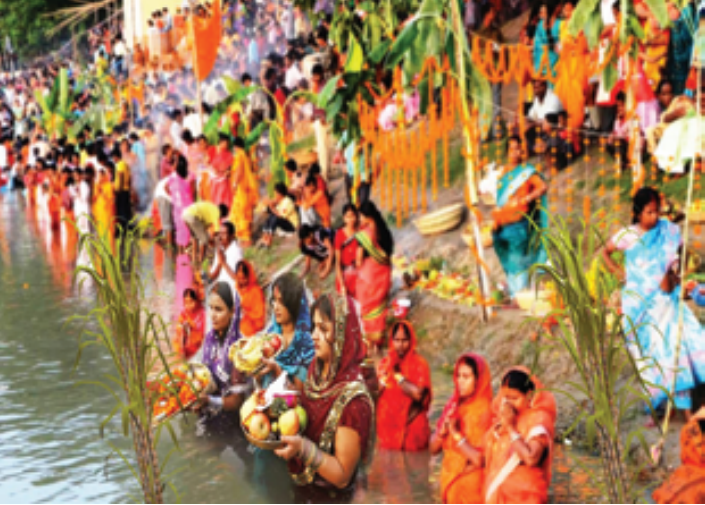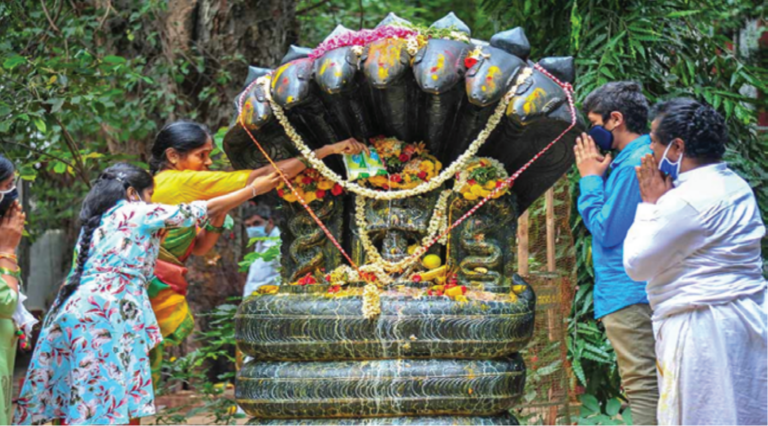Ruchi Verma enlists the festivals celebrated round the year and says India pays homage to nature’s gratuity through a spectrum of festivals. These celebrations are rooted in agrarian traditions, rain rituals and a deep-seated respect for the flora and fauna that sustain life. From the monsoon festivals that welcome life-giving rains to the harvest festivals that honour the fruits of labour, these cultural expressions mirror the intimate connection between humans and nature in India.
India is a country that has a deep connection with nature and this is reflected in the many festivals that celebrate the elements of nature. Tales, folklore and mythology are filled with incidents and observances of revering and worshipping nature.
A land of diverse landscapes and rich biodiversity, India pays homage to nature’s bounties through a myriad of festivals. These celebrations are rooted in agrarian traditions, rain rituals and a deep-seated respect for the flora and fauna that sustain life. From the monsoon festivals that welcome life-giving rains to the harvest festivals that honour the fruits of labour, these cultural expressions mirror the intimate connection between humans and nature in India.
Chhath Puja, celebrated in the northern and eastern states of India, particularly Uttar Pradesh and Bihar and in Jharkhand and parts of Nepal, is dedicated to worshipping the Sun God and nature. It is a four-day festival that takes place in October or November and it involves fasting, offering prayers and taking a dip in the holy waters of a river.
The devotees worship the Sun God seeking his blessings for a healthy and prosperous family. The rituals of this festival have been mentioned in ancient scriptures including the Rigveda. There are references in Mahabharat also where Draupadi performs the Chhath Puja rituals.
Worshipping the tree
A key festival celebrated across the tribal state of Jharkhand in central India is Sarhul. It is celebrated in spring on the third moon day of the Hindu calendar’s first month. Participants pray to the trees during Sarhul, which marks the advent of spring. The festival is dedicated to celebrating trees and is a way of thanking nature for its bounty.
People start the celebration by gorging on sarai, a local wild fruit, as well as rice beer. They dance to the tunes of a variety of local musical instruments. This three-day festival is at its liveliest on the final day when tribals, and visitors alike, dance their way through the streets in a shobha yatra (grand procession) while singing and dancing to local songs. It’s mainly the Oraon, Munda and Ho tribes of Jharkhand that observe this festival which usually falls in March-April when the Saal tree grows new leaves.
Interestingly, during this festival, all the rituals and the food is derived from or are a part of the trees. The prasad (offering to god) is prepared from tree leaves mixed with rice and water and is called a handia. Other food specialties include pahan, khadi and several fish preparations.
A countrywide festival that celebrates the planting of trees is the ‘Van Mahotsav’. It is celebrated in the first week of July every year, and it was started in 1950 by the Ministry of Agriculture to create awareness about the importance of trees and forests. During this festival, people plant trees and take a pledge to protect them. The festival is celebrated across the country, and it is a way of promoting afforestation and environmental conservation.
Gauri and nature
Bathukamma, a festival celebrated in the state of Telangana, is dedicated to the worship of Goddess Gauri. Women make small idols of the goddess (boddemma) using mud and decorate them with flowers. After nine days, the idols are immersed in nearby ponds. This helps reinforce the pond and helps it retain more water. Certain flowers, when immersed in abundance, also are believed to purify the water. The festival heralds the beauty of nature and the collective spirit of women folks towards preserving the resources.
The colourful floral festival is celebrated before the onset of the winter season, during the lag end of the monsoon season. At this time, the most abundant flowers in the region are the gunuka, tangedu, banti, chamanti, nandi-vardhanam, etc., and are widely used in the festival.
Another important ‘natural’ food during this festival is the custard apple or sitaphal or shilpakka pandlu. The festival commences seven days before the Saddula Bathukamma which is two days before Dussehra. The Bathukamma or the floral arrangement of native flowers is offered to the family deity and worshipped. It celebrates human’s inherent relationship with nature and earth.
It must be noted that during the ten-day Ganeshutsav that is a very popular festival celebrated pan India, there is one day dedicated to Gauri. In certain parts of India, especially in the Konkan region, on this day the women worship the tilda plant and its flower represents Gauri. The traditional customs of this festival are sustainable and environment-friendly in manner.
Karaga festival that is primarily celebrated in Karnataka is a unique blend of nature worship and mythology. It is one of the oldest festivals of Karnataka. Here, the deity of Draupadi, symbolised by an earthen pot adorned with flowers, carried by a priest on his head, is venerated. This act is a tribute to Mother Earth’s nurturing spirit and serves as a reminder of our responsibility to protect and preserve the environment.
Karaga means a mud pot. The festival is integral to the Thigala community found in Karnataka and Tamil Nadu and is an integral part of their cultural and religious heritage. The festival is derived from Mahabharat’s episode where Draupadi was stripped by the Kauravas and celebrates her strength, the goddess of strength or shakti.

Nature’s friends
Animals and birds are an integral part of nature and play an important role in maintaining ecological balance. They are also revered as symbols of divinity or as companions of gods and goddesses in Indian culture.
There are many festivals that celebrate animals and birds as well as raise awareness about their conservation. Some of these festivals are Nag Panchami, Ayilyam Mahotsavam, Velas Turtle Festival, Elephant Festival, Bird Festival, Jallikattu, etc.
The Bird Festival celebrated in Uttar Pradesh is dedicated to the appreciation of birds. With talks and nature events around the 500-plus bird species found in Uttar Pradesh and over 1,000 species in the country, this festival is a must-visit for both amateur birders as well as seasoned naturalists. The festival provides the perfect opportunity for wildlife photographers, nature and bird enthusiasts and naturalists to be blessed with sightings of stunning birds, both common and rare.
Organised by the Uttar Pradesh Forest Department, this festival aims to create awareness about the wildlife – native and migratory birds that travel around the world to visit the various water bodies in northern India, promote eco-tourism and sustainable living practices for the preservation of biodiversity and natural resources.
Nag Panchami venerates snakes as divine creatures with mystical powers. It is celebrated on the fifth day of the bright fortnight of the month of Shravan. It is celebrated by offering milk, flowers and sweets to snakes and worshipping them. Ayilyam Mahotsavam is a festival that is dedicated to serpent deities. It is celebrated at the Sree Nagaraja Swami Temple in Kerala where special rituals are conducted to appease the serpent gods.
Velas Turtle Festival is celebrated in Maharashtra to spread awareness about the conservation of the rare Olive Ridley Sea Turtles. It is celebrated by hosting home stays with the villagers and releasing the turtle hatchlings into the sea.
Jallikattu is a traditional rural sport of taming bulls. It is celebrated in Tamil Nadu during Pongal, on Mattu Pongal day, where young men try to hold on to the hump of a bull as it tries to escape. It is also known as Eru thazhuvuthal or Sallikkattu or Manju virattu.

